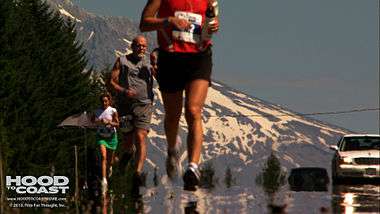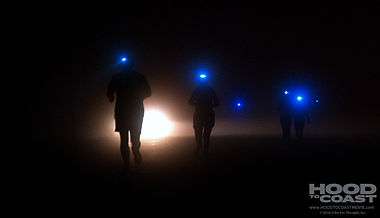Hood to Coast

The annual Hood To Coast Relay is an overnight, long-distance relay race held in the U.S. state of Oregon, annually in late August, traditionally on the Friday and Saturday before the Labor Day weekend. It is one of the longest and largest relays in the world (with 12,600 in Hood To Coast Relay, 18,000 total participants, including Portland To Coast Walk Relay and High School Challenge Relay). Considered to be on the "bucket list" for many a runner and walker, Hood To Coast has filled its team limit for the past 25 years, and 18 straight years on "Opening Day" of the lottery. The course runs approximately 320 km (200 mi) (the course length changes by 1-5 km each year due to small changes made by race organizers) from Timberline Lodge on the slopes of Mount Hood, the tallest peak in Oregon, through the Portland metropolitan area, and over the Oregon Coast Range to the beach town of Seaside on the Oregon Coast.
Walkers and high school teams may choose to compete in the Portland To Coast Walk or Portland To Coast High School Challenge respectively, both of which are held in conjunction with the main relay and start in downtown Portland instead of Mount Hood.
2016 unveiled a new venture, called Hood To Coast China, in conjunction with Yao Ming's company, Starz Sports. Hood To Coast China will be a similar relay in Shandong Province.
History
The relay was started by Portland architect Bob Foote, who was then president of Oregon Road Runners Club. The first relay in 1982 drew eight teams that ran from Timberline to Kiwanda Beach near Pacific City, Oregon. The relay grew rapidly to over 400 teams by 1986. In 1989, the finish area was moved to Seaside where it remains today.
Like many businesses, the Hood To Coast Relay is a for-profit family owned business. While cancer research and fundraising had been a longtime partner of the event, it had not been prominently promoted in the race until Foote himself was diagnosed and successfully treated for melanoma in 2005. The race then began to take on a more aggressive approach to fundraising, and in 2015 alone, over $550,000 was raised for charity partner, the Providence Cancer Center, making it the second largest road race cancer fundraising program in the nation.
In 2006, Foote's daughter, Felicia Hubber, joined the family business to manage the majority of race logistics. She is Race Director and President of the company. [1]
Teams
Open to all interested competitors, but limited to 1,050 twelve-person teams, Hood To Coast has filled its limit on opening day for the past 18 straight years. Teams each year are chosen by lottery from the entries postmarked on opening day of registration, typically in October of the previous year. The Portland To Coast Walk and High School Challenge are limited to 400 and 50 teams respectively; entries are accepted on a first-come-first-served basis until all spaces are filled. http://www.portlandtocoastwalk.com/
Course

The 320 km (200 mi) Hood To Coast course consists of 36 legs; each team member runs three in rotation. The course is run primarily on paved asphalt roads and paved asphalt or concrete multi-use off-street paths, with small portions of the course on sidewalks and gravel roads. The legs vary in length from 5.4 km (3.4 mi) to 12.5 km (7.8 mi); some legs are virtually flat, and others descend and/or ascend steep hills. Consequently, a runner may total between 21.9 km (13.6 mi) and 31.7 km (19.7 mi). Teams in the full Hood To Coast relay must complete the course within a 32-hour time limit (averaging under 5:50 per kilometer or 9:30 per mile).
Teams start on Friday between 5:30 a.m. and 4:45 p.m. in staggered waves of approximately 20 teams every 15 minutes. Teams are seeded based on previous race pace times (extrapolated based on a specific deterioration factor over three legs, and taking into account additional factors) for each team's submitted roster. Thus the flow of teams through the 35 exchange points and finish line remains relatively smooth, with all teams finishing the race by the closing time of 9 p.m. on Saturday.
The course starts at Timberline Lodge at the 6,000-foot (1,800 m) level of Mount Hood, and proceeds down Timberline Road to Government Camp. This first leg drops 2,000 feet (610 m) in elevation over about 6 miles (9.7 km); the next two legs from Government Camp to Rhododendron have a combined elevation drop of 2,300 feet (700 m) over about 10 miles (16 km).
Runners proceed west along U.S. Route 26 to the towns of Sandy and Gresham, where the route proceeds along the Springwater Corridor trail to the Sellwood neighborhood in southeast Portland. The route then proceeds north along the paved Springwater/Willamette River trail and crosses the Hawthorne Bridge west into downtown Portland.
After crossing the Hawthorne Bridge, runners proceed north along Naito Parkway in downtown Portland along the west bank of the Willamette River and onto U.S. Route 30 to St. Helens. From there onward, the route passes through hilly rural and sometimes unpaved backroads through the communities of Mist and Birkenfeld on the way to the finish line in Seaside.
The Portland To Coast Walk Relay and the High School Challenge Relay follow the last 24 legs (129 miles) of the course, starting from the Hawthorne Bridge in downtown Portland. Each participant in these relays walk or run at least two legs in rotation.
Logistics and atmosphere
Each twelve-person team is allowed two vehicles no larger than a standard-sized van. While the vans generally follow the race course in support of their runners, certain narrower portions of the course require one van to make a detour to alleviate traffic congestion. Teams usually give themselves funny or original names and decorate their vehicles according to a theme. Race organizers announce the winners for best team name, best van design, best team outfit, and outstanding volunteer, (as voted by teams) at the awards ceremony on Saturday evening, and on the HTC website.
Teams are expected to provide their own provisions, including food and water, and to ensure their own safety; there are no promised aid stations or police protection on the course. Local schools, granges and churches along the route provide sleeping areas, food, and showers to participants as fundraisers (see HTC handbook). Teams compete in divisions based on gender (men, women, and mixed) age (based on the age of the youngest participant) or corporate sponsor. At the Finish Area Stage, an awards ceremony by division is conducted, along with photos taken with the winning Hood To Coast team, which is presented with their name engraved on a large leaded glass goblet trophy.
All teams that include at least one member living within a 100-mile (160 km) radius of Portland are required to provide three volunteers to ensure adequate personnel at turns and exchanges along the course race.
Media
The race is the subject of the 2011 film Hood to Coast, directed by Christoph Baaden. The film chronicles four teams who ran in the 2008 race. The film premiered at the 2010 South by Southwest Film Festival and was released in theaters in North America on January 11th, 2011.
References
- ↑ Boaz Herzog, "The anchor leg in world's largest relay", The Oregonian, August 25, 2006.
External links
- Hood to Coast website
- Hood To Coast China
- Hood To Coast the Official Movie Website
- Hood to Coast at the Internet Movie Database
- Portland to Coast Walk website
- Portland to Coast High School Challenge website